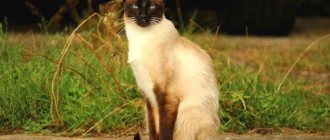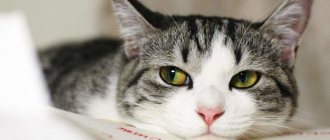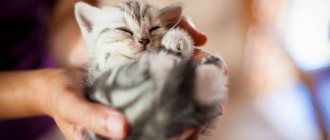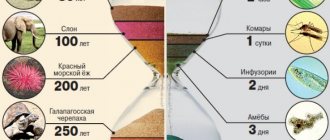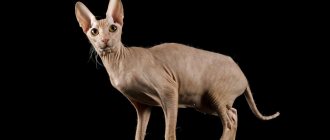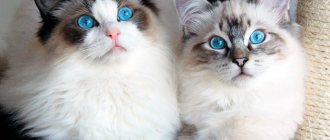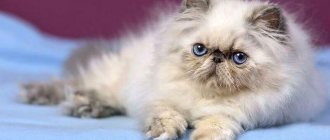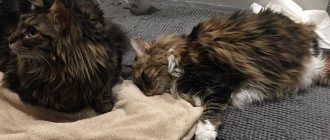Despite the unusual appearance and peculiarities of care, the life expectancy of the sphinx differs little from its relatives. These creatures live from 9 to 15 years, on average up to 12, but there are rare cases when a cat has lived to be twenty years old. If the animal is a full member of the family, it is important for the owner to familiarize himself with the rules that will help prolong the life of his beloved pet.
The longest life expectancy of this breed is 30 years.
Contents in the house
Sphinxes are simply an ideal choice for people who do not like coolness and suffer from low temperatures. Frozen cats, taking a cat in their arms, pressing it to their body, feel a surge of warmth. In vain it seems that the pet suffers from high body temperature in sphinxes; this is their normal state, which can reach up to 38-39 degrees, and in kittens sometimes reaches up to 42. The sphinx can become a good heating pad for the owner. The cat family is warm-blooded, but in hairless sphinxes, this is more pronounced due to the almost complete absence of hair.
The appearance of the sphinx with large ears, with a body on slender long legs, almost devoid of hair, makes it look like mysterious aliens. Caring for them and keeping them is much more complicated, unlike other fluffy cats. Is as follows:
- special care is needed for human-like skin with a tendency to sunbathe and sweat;
- it is necessary to maintain a comfortable temperature and humidity in the house;
- attention is required for the short “suede” fur, which is covered with folds of skin;
- the skin requires regular water treatments, washing and bathing;
- when sweating occurs, wipe the body with a damp soft cloth or napkins;
- due to the lack of eyelashes, it is necessary to clean the eyes of mucus daily;
- huge ears need cleaning due to sulfur discharge from the shells;
- sharp claws are trimmed regularly;
- In winter, prepare a warm shelter for sleeping and clothes for walking.
Sphinxes also love attention, it is important for them to communicate with members of the household, they love games and conversations.
Train to the tray
To accustom a Sphynx kitten to the litter box, you must not only choose the right container, but also place it in a secluded, quiet place, away from food bowls. To find a suitable filler for him, you can take, as a sample, a small portion of granules from the breeder with the smell familiar to the kitten.
If the kitten has not started to go to the litter box on its own, then it needs to be weaned from shitting in the wrong place; to do this, they wait for the beginning of the process and take the poor fellow to the litter box to continue the toilet. This way he will understand that he needs to go to the right place. This is usually done when the baby has eaten or after sleep. The tray must be cleaned regularly. The area in the apartment soiled with feces is well disinfected with products that do not contain chlorine.
Important! You cannot punish the kitten, scream, poke your nose, the baby will get scared and will not soon understand what is required of him. Only with patience and affection can you accustom your pet to the tray.
History of the breed
The Don Sphynx cat breed appeared recently. Breeding was carried out in Rostov-on-Don. That is why the breed got its name. In the late 80s, one woman picked up a kitten on the street. After some time, he began to lose his fur. At the veterinarian, the woman found out that this was not a disease, the cat felt fine. When she was bred to a regular cat, one kitten was born hairless. It turns out that the breed was not bred artificially, but appeared by chance.
Felinologist I. Nemykina became interested in the unusual kitten. She began to breed hairless cats, using Oriental cats, European shorthairs, and Siamese for crossing. But the breed did not immediately become popular. At first, the breeder just gave away kittens. When cat owners learned about the benefits of keeping unusual pets, they began to be considered a luxurious gift.
Due to the characteristics of the mutation, these cats give hairless offspring even from ordinary cats. A dominant gene is responsible for the lack of hair, so these cats have nothing in common with the Canadian Sphynx. The new breed was recognized in 1996. At first she was called the Russian naked, the Don bald head, but then she received the name Don Sphynx. The breed is now recognized by the World Cat Federation.
Only since the beginning of the 21st century has the breed become popular outside of Russia. At first, Donchaks were crossed with European shorthairs. Then the number of individuals suitable for breeding increased, and other breeds were no longer used for crossing.
Please note: When crossing the Don Sphynx with Siamese cats, Russian Blues and Turkish Angora, a separate branch of the breed appeared - the Peterbald.
Healthy lifestyle
Caring for and maintaining sphinxes in the house is a great joy, but also a certain hassle. Like all of the cat family, the life of the hairless breed is short-lived, and how long Sphynx cats live largely depends on many conditions to ensure a happy and healthy life in the house, which can increase the life expectancy of hairless animals.
The following factors influence life expectancy:
Normal weight
Sphynx cats are prone to overeating, so you need to keep your pet's food intake under control. If cats are not restricted in their diet, they will become obese, which leads to health problems.
Movement
So that the pet can avoid gaining excess weight and to ensure energy expenditure, a playground is installed for it and they are provided with outdoor games. This will keep your pet in good physical shape.
Cleanliness and hygiene
Maintaining cleanliness is due to the fact that specific fat is secreted on the naked body, in the folds. Germs multiply on the skin if you do not bathe daily or when you wipe it coldly. Regularly wipe eyes and ears to remove discharge.
Body temperature
Hairless Sphynx cats do not have fur that can protect them from freezing. Changes in temperature make them catch cold easily. Therefore, they buy warm clothes for the winter and equip them with a cozy, warm place to sleep.
Tan
Hairless cats get burns after prolonged exposure to the sun. Therefore, they provide protective capes and protect them from direct midday rays.
Curiosity and Curiosity
Light, agile sphinxes are not only inquisitive, but also curious; in order to protect against injury, they remove dangerous objects away.
Loneliness
Sphynxes do not like to be alone; they get very bored when their owner is absent for a long time, so it is recommended to keep them in pairs or with another animal.
Heredity, diseases
The presence of long-lived grandparents gives a chance that the pet will not have congenital defects or diseases. It is very important to maintain good immunity by providing your pet with a nutritious diet.
Sterilization, castration
How long a Sphynx cat lives depends on the fact that if the owners do not plan to have offspring, then after sterilization, her hormonal processes are regulated, diseases of the reproductive system do not occur, diseases of the mammary glands do not appear, and her lifespan increases.
If the above conditions are met, the period of a happy and healthy life of sphinxes is extended, on average it is 9-12 years, but can reach up to 15 years.
Raising a pet
A four-legged friend must have a scratching post so that he doesn’t ruin your furniture.
Four-legged friends can be vulnerable. They need to be raised without scolding or pressure, otherwise the animal may become offended. Sphynx cats may have trouble getting used to the litter box. When training your cat to use the litter box, you need to be patient.
Spray the areas where your pet goes to the toilet with water and lemon juice or citrus-scented essential oil. The aroma will scare away your pet and help prevent the animal from repeating the trick.
At an early age, Don Sphynxes love to sharpen their claws and also often scratch. Therefore, it is worth purchasing a sharpener in advance, as well as a sufficient number of toys. Then the owner will be able to keep the furniture intact. In addition, if a small kitten is busy with an item purchased for it, it will not attack the hands and feet of the residents of the house. For very active tailed animals, it is worth purchasing a special play complex. In order for the animal to quickly learn the rules in the house, it is necessary to give it enough attention.
Sphinx food
Sphynx cats have a natural tendency to overeat, so high-quality, balanced nutrition guarantees your pet's good health and development.
The exotic breed of Sphynx needs a high-quality diet and a strict regime. What to feed the Sphynx in order to ensure activity and maintain a comfortable body temperature, the pet needs food containing more calories. The diet depends on the type of food chosen:
- Ready-made factory food is balanced in its content of vitamins and minerals.
- Natural homemade food is of higher quality, but requires a special set of products to provide the Sphynx with all the necessary components for proper nutrition and development.
Diet for a kitten
At 3 months of age, for a kitten moving to live in the owner’s house, they choose the type of food: natural food or ready-made specialized factory food for kittens. The new food should correspond to the previous usual diet in the first weeks, new components are gradually added, so the Sphynx’s body will painlessly switch to a new food for it, which will be completely absorbed.
For busy owners, deciding what to feed a Sphynx kitten is simple. It is convenient to organize your pet’s meals using ready-made kits. Many companies have proven their products to be of high quality, for example, manufacturers of the Royal Canin brand. With such a diet, the Sphynx needs large amounts of water with round-the-clock access.
Starting from 3 months, the little sphinx’s diet and nutritional requirements are gradually replenished with meat, dairy products, and cottage cheese. Add vegetables and herbs.
The meat is given raw, frozen, and rolled into minced meat. Meat products include beef, all types of lean game, and offal.
All types of porridges from different cereals, finely chopped boiled or raw vegetables and herbs are added to the minced meat. When choosing vegetables, they look closely at the kitten’s preferences; some do not eat beets, while others do not eat cabbage.
Important! Deep freezing of meat products kills all pathogenic microbes and helminths.
At 3 months, the serving size of a Sphynx kitten is approximately 25 grams with feeding 7-8 times a day. Gradually, at 4-6 months, portions are increased to an average of 50 grams and feeding is reduced first to 5-6, and then to 3 times a day. Provide free access to fresh, bottled water, which is changed daily.
Important! Scheduled feeding is convenient not only for the owner; you can control the amount of food the kitten eats and plan your time. It is useful for the Sphinx to eat on time; the stomach adapts to digestion, which reduces the risk of overeating.
Diet for an adult
For sphinxes, both natural and ready-made food are useful. Factory kits have a balanced composition and are supplied with the necessary substances and vitamins. For hairless cats and any cats of other breeds, natural food is preferable and tastier, but the owner needs to monitor its components, including the vitamins and minerals the animal needs for development and replenishment of the energy balance.
Table No. 1 : composition and nutritional standards for an adult Sphynx
Porridges and vegetables are given mixed with meat and vegetables with the addition of vitamins, and you can add greens.
Ready-made feed
For owners who do not have the time and opportunity to feed their pet prepared natural food at home, ready-made food can help in this case.
There are many companies on the market that produce products for cats. One of the oldest, the French company ROYAL CANIN, has been producing products for animals, including the Sphynx breed, for more than 50 years. Since 1968, the company has been developing high-quality premium products for nutrition and maintaining the health of cats from birth to old age.
Table No. 2 : Royal Canin food line for sphinxes
Advice! To strengthen bones and maintain your pet’s nervous system, it is useful to add 1 drop of vitamin D to food daily.
Sphynx weight by month
For the Sphynx, from birth it is necessary to balance the diet, avoid overeating and monitor the normal weight.
By the year, the average, one-year-old weight of a sphinx is from 2.5-3 kg, and for a cat up to 4-4.5 kg, they try to stick to it in the future.
Important! To correctly calculate the amount of food, take approximately 5% of the pet’s body weight and then adjust this volume.
Kittens are separated from their mother's diet after 3 months and transferred to 4-6 meals a day with basic food. To properly monitor the development of a kitten, the owner is recommended to weigh the pet by month to one year.
Table No. 3 : Average weight of the Sphinx by month.
Determining the age of the kitten
Finding out the age of a kitten is much easier than finding out an adult cat. Kittens grow and develop very quickly in the first year of life. It is possible to determine how many months they are with virtually no errors.
By behavior
- Up to 3 weeks, babies do not respond to external stimuli.
- At the age of 1 month they begin to walk slowly.
- By 1.5 months. The kittens are already running around actively.
- At 2 months they can come into contact with humans and other animals.
- By 5 months Puberty occurs in teenage kittens. This can be determined by the pet’s changed behavior. The cat or cat begins to behave restlessly and meow loudly.
- At 7 months sexual hunting begins. The cat asks the cat, the cat can mark the territory.
Tough
- At 1 month Kittens have their first incisors.
- By 1.5 months. premolars and canines appear. By 3 months - molars.
- At 3 - 4 months. Kittens lose their baby teeth and their permanent teeth appear.
- By 7 months they have a full set of permanent teeth: 4 molars, 4 canines, 12 incisors and 10 premolars. The teeth are white and very sharp. There are no damages or abrasions on them.
Sphynx care
Maintaining hygiene and caring for the Sphynx requires great attention; they do not have a protective coat, and their eyelids do not have eyelashes.
- Monitor the condition of the skin and keep it clean. Constant sweating, many sebaceous glands secreting fatty secretions cover the body with a dirty film and smell bad. To keep the skin clean and healthy, your pet is often bathed and wiped with wet wipes.
- Dust and dirt accumulate in the large form of the ears, which leads to dark waxy discharge. Care and maintenance of the Sphynx ears consists of removing mucus using swabs and cotton swabs.
- In the evening, discharge accumulates on the mucous membrane of the eyes, unprotected by eyelashes; they are transparent, similar to tears, and must be regularly removed with wet wipes. Dark, purulent accumulations in the corners indicate infection. In this case, immediately seek advice from a veterinarian.
Skin care
The skin of hairless cats resembles human skin and requires constant care for sphinxes, which includes the following hygiene procedures:
- Bathing, more often 2-3 times a month.
- Wiping with a damp cloth or napkins.
- Moisturizing will help regular baby cream to peel off and even peel off.
Washing and bathing
Hairless cats often sweat, so you need to know how to wash your Sphynx. The opinion about daily bathing is not entirely true. How often to bathe the Sphynx will be determined by the condition of the skin and the degree of its obesity.
You can navigate by the following signs:
- unpleasant pungent odor;
- unpleasant stickiness of the skin;
- fatty grayish dirty coating;
- accumulation of dirt in the folds of the skin;
All these signals will answer the question of how often to bathe the Sphynx, that it is time to bring the pet’s skin back to normal, to give the skin a clean suede look that is pleasant to the touch.
How to bathe a Sphynx kitten and when, many breeders recommend starting no earlier than 3-4 months of age. For kids, there is a risk of catching a cold and getting stressed from water procedures. While they live with their mother cat, she takes good care of hygiene and constantly licks them until they shine.
You should not frequently bathe a bald pet for more than 2-6 weeks, regardless of the degree of skin contamination, for the following reasons:
- Sphynxes are warm-blooded creatures and have a high body temperature, and after swimming they become hypothermic.
- Even specially selected shampoos and water damage the function of the sebaceous glands, which protects against external irritations and infections.
If absolutely necessary, if a hairless cat has soiled part of its body, it is wiped with a damp sanitary napkin with a neutral composition and odor, as for small children.
Before starting a bath, you need to prepare bath accessories and the sphinx itself, especially before the first bath in its life.
For swimming you will need:
- a large basin, in the bathroom for many it is inconvenient to wash a nimble, soapy pet;
- container with water for rinsing, the water temperature remains within 37-39 degrees.
- acquire a soft, delicate sponge, as for bathing a child;
- sanitary napkins will be needed to wipe the face;
- prepare 2-3 towels for wiping a wet pet dry;
- When swimming, all doors, windows, and vents are closed to prevent drafts.
The procedure for bathing a prepared sphinx consists of the following manipulations:
- cover the bottom of the basin with a towel or silicone mat;
- water is poured into the basin only until the paws are covered;
- calmly place the pet in the basin, gently stroke it;
- after the cat gets used to the water, apply shampoo to the sponge and massage the body;
- carefully remove the shampoo with prepared water until the soap is completely washed off;
- The body is wiped with a towel, and the face, eyes, and ears with a napkin.
When bathing the Sphinx, follow the following recommendations:
- the cat is not fed before bathing; it will tolerate the procedure easier on an empty stomach;
- in order not to scare the cat, it is useful to foam the water before bathing;
- You can wash your cat only 2 weeks after vaccination.
- you cannot bathe the sphinx in a cold room with a temperature below + 28-30 degrees;
- It is difficult and impractical to wash two animals at the same time;
- It is forbidden to bathe a pet if it is unwell.
Shampoo
Special shampoos for bathing and body care are available for sale for Sphynx cats.
Important! It is not allowed to wash the Sphynx with shampoos intended for other breeds of cats or for humans. They have compounds that are not suitable for the skin of hairless cats, which clog pores and cause irritation.
- “Ms.” is recommended especially for sphinxes. Kiss Graceful Sphinx contains biotin, which not only nourishes the skin, but also relieves irritation and itching.
- Shampoo-conditioner “Doctor VIC for hairless cats (Sphynx)” moisturizes the skin, relieves inflammatory irritation and itching. Enriched with keratin and provitamin B5.
- Foam shampoo “Le Artis for hairless cat breeds” . developed taking into account the characteristics of the skin with components that carefully cleanse and moisturize the skin.
Recommendations for using shampoos:
- shampoo is suitable for water with any hardness;
- the animal is well moistened with warm water, within 37-39 degrees;
- a little shampoo is dripped onto a sponge and distributed over the body with massage movements, forming soap foam;
- Allow the skin to loosen for a few minutes and rinse thoroughly with warm water;
- Wipe your body and ears dry with a towel.
Ear cleaning
Dust and dirt accumulate in the large ears of the sphinx, and sulfur is produced in the shells.
It is necessary to wipe the ears once a week with a special solution to remove accumulated discharge with a cotton swab.
Claws (nail trimming)
A special scratching post and a sharpener for the pet’s claws are installed in the house for the sphinx, but this is not enough; the pet’s claws must be trimmed. Naturally active hairless cats can be injured by overgrown claws and damage their delicate bare skin, which can lead to infections and skin diseases.
Life expectancy of a giving birth cat
Puberty occurs in Sphynx girls between six months and 12 months. Experts recommend that the first mating be carried out no earlier than after a year.
To prevent pregnancy and subsequent childbirth from harming the body, this process should be planned no more than 1-2 times a year.
Pregnancy can be harmful to an animal that has reached the age of 7 years, so kittens should not be planned after this period. In general, whether a cat has given birth or not will not affect its life expectancy. The main thing is to comply with all breeding conditions.
Health and diseases
Experts do not classify the Sphynx breed as an animal with poor health. The immunity of born kittens is normal; the Sphynx rarely coughs, but like the entire cat family, they can be susceptible to viral and bacterial infections.
The peculiarities of the breed are caused by the fact that Sphynxes were bred by breeders artificially through inbreeding in order to achieve a unique mutation with smooth, rubber-like, hairless skin with many folds. As a result, a unique breed was developed, but prone to genetic abnormalities that lead to sphinx disease and abnormalities in the development of organs: eyes, skin, mouth and spine.
The main diseases of sphinxes and pathologies:
- skin diseases, fatty sweating caused by bare skin, almost without hair;
- eye diseases and eye abnormalities, the cause is the absence of eyelashes;
- shortened lower jaw in the oral cavity or “carp bite”;
- underdevelopment of the thoracic and lumbar vertebrae, a common congenital disease;
- reduced growth as a consequence of serious defects.
My eyes are watering
Newborn kittens are predisposed to eye diseases caused by inflammatory processes of the cornea, causing conjunctivitis and scleritis. Eyes that are not protected by eyelashes, and sphinxes simply do not have them, are injured, and debris, dust, and dirt get under the eyelids, which cause inflammatory processes:
- Catarrhal conjunctivitis manifests itself as clear discharge in the form of lacrimation. The membranes of the eyes are marked by redness and swelling, the animal feels pain.
- Infectious purulent conjunctivitis with characteristic gray-green discharge.
From birth, kittens' eyes are given special attention, daily examinations are carried out, and they are washed with furatsilin. Specks are removed from under the eyelids and mucus is removed. Do not allow your eyes to water too much.
Attention! If purulent or infectious discharge appears, self-medication is not allowed; you must consult a veterinarian for advice.
Entropion of the eyelids
The most common pathology is entropion of the eyelids in the Sphynx, which manifests itself in kittens from birth. The disease is determined externally; the eyelid bends inwards, which is very disturbing for children; they suffer from continuous conjunctivitis, discharge in the form of tears and possible infectious purulent discharge. The only way to help kittens get rid of entropion is through surgery.
Attention! Surgical interventions are corrective in nature, which does not completely eliminate the pathology, but leads to some improvements.
Lichen
Kittens with weak immune systems and adults are more often at risk when lichen occurs in the Sphynx when interacting with sick animals or when being in an infected environment. <Dermatophyte> (lichen) is a fungal skin disease that is seasonal and often occurs in cats after estrus. It manifests itself in the form of inflamed, shabby lesions, eczematous areas in which the skin itches and peels.
Attention! Ringworm is a serious, contagious disease that will not cure itself. When the first signs appear, treatment is prescribed by a veterinarian.
When a pet is diagnosed with lichen, the doctor prescribes long-term treatment with medications and treatment with antimicrobial agents, with mandatory compliance with all procedures. Infection with lichen can be prevented by timely vaccinations against all infectious diseases, which are given on schedule.
Skin rash
A rash on the skin of the Sphynx can appear in both male and female cats at any age, completely devoid of “rubber” fur. Rashes occur during active puberty, caused by hormonal secretion of sebum.
Acne (acne) due to the hereditary predisposition of the breed is observed:
- on the back along the spine;
- on the face;
- on the surface of the abdomen;
- under the jaw with the neck;
- in the form of black dots on the tail.
Infection of the skin with acne spreads throughout the body of sphinxes with a certain color. Mostly blue, blue-cream and red animals that are completely naked without hair are susceptible to acne. In flocked plants, rash is less common.
For treatment at home, gels and solutions such as “Zinerit”, “Minocycline”, or “Lindamycin” are used. For mild forms of spread, rubbing with salicylic acid and hydrogen peroxide helps. For severe forms of the rash, consult a veterinarian.
Inflammation of the rash as a result of bacterial activity develops both on the surface of the skin and deep in the subcutaneous layer. There are 2 types of acne:
- Comedones on the surface of the skin with a mild inflammatory process.
- Ulovatocystic acne with deep formation of purulent cystic cavities, manifesting itself in the form of fistulas with the formation of scars.
Advice! Avoid keeping your pet in the sun for a long time.
Dermatitis
When the owner adheres to keeping the pet only at home, then dermatitis in the Sphynx has little risk of being detected on the skin. It is possible to become infected with a similar skin disease by bringing secondary infections into the home.
Dermatitis, when it is impossible for cats to scratch the sore spot, may spontaneously disappear without the use of medicinal drugs. In severe cases, it is enough to use Dexafortor, a single infection or Terramycin spray.
External signs
Hairless cats have almond-shaped eyes
Don Sphynxes stand out for their bright appearance. These are animals with strong bones and developed muscles. Like all breeds, they have their own standards. We will consider the description of the appearance of the purr of this breed below.
Dimensions and weight
Representatives of this breed are medium-sized. Animals grow up to 30 centimeters at the withers. An adult cat weighs from 3 to 5 kilograms. The weight of a large cat is up to 7 kilograms. Neutered pets quickly gain weight. The body temperature of the tailed animals is about 38.0–39.5 °C; when touching the sphinx, the owner may feel that the pet is hot.
Anatomical characteristics
A purebred cat must meet accepted standards. Main characteristics of animals:
- wedge-shaped head;
- straight nose;
- large, widely set ears;
- almond-shaped eyes;
- small mustache (sometimes completely absent);
- toned body with strong muscles;
- elongated silhouette;
- folds on the head, neck, groin and armpits;
- limbs of medium length with elongated fingers;
- long and flexible tail.
Velor Don Sphynx
Skin and color
Don Sphynxes have smooth and elastic skin. There are both solid and spotted and striped pets. They come in different colors. Among the representatives of this breed are often found: the black Don Sphynx, the red cat, as well as the tortoiseshell and white tailed cat.
Depending on the length of the coat, there are four types of sphinxes of this breed:
- Bald. They have no fur at all. They are the most valuable sphinxes.
- Folk. The body of such purrs is covered with short hair. If the animal does not have genetic defects, then by the age of two the pet is completely bald.
- Velours. Sphynxes with fur that grows up to 3 millimeters. Basically, with age, cats of this species become “naked”.
- Brush. Tailed animals with hard and sparse hair.
Breed faults
Defects that may cause an animal to receive low marks at exhibition events include:
- narrow and short head;
- Round eyes;
- small tail;
- undershot less than 2 millimeters;
- small, low-set ears;
- weak body.
Does castration prolong the life of cats?
It is impossible to say unequivocally how long castrated Sphynx cats live. But we can say for sure that the operation will extend the life of the pet by two or even three years. Neutered cats are calmer, more balanced, they do not run off for walks, do not disappear for a long time, and the possibility of contracting sexually transmitted diseases is completely excluded.
Of course, there are also disadvantages to castration: the cat’s hormonal levels may become disrupted and obesity may appear. In order to avoid such problems, you need to feed your pet balanced food and monitor the amount of food consumed. It is difficult to monitor the standards for the food eaten by sphinxes, because they eat a lot even if they are not castrated. Large amounts of food are necessary to regulate body temperature. Since cats are hairless, they freeze, losing a lot of energy, hence the need to absorb large amounts of food.
